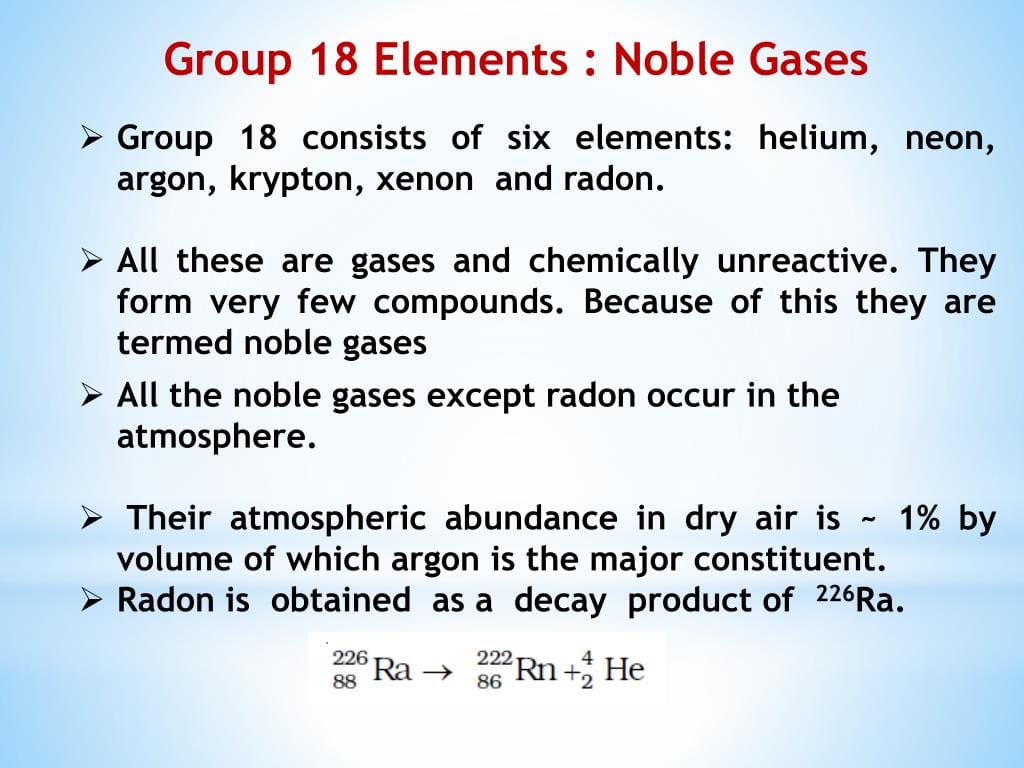Ready to venture beyond krypton on the periodic table? Journey down to the next noble gas: xenon. This mysterious element, while lesser-known than some of its flashier counterparts, boasts fascinating properties and unexpected uses. Join us as we unravel the secrets of xenon, from its intriguing behavior to its vital role in technology and medicine.
Xenon’s Place Among the Nobles
Xenon (Xe) claims its spot directly below krypton in Group 18 of the periodic table. This exclusive group, known as the noble gases, share a common trait: they’re notoriously independent. Their electron shells are full, making them stable and generally unreactive with other elements. Think of them as the introverts of the periodic table, content in their own company.
But xenon, it seems, didn’t get the “inert” memo. Unlike its lighter noble gas siblings, xenon exhibits a rebellious streak. It can actually form compounds, particularly with highly electronegative elements like fluorine and oxygen. This unexpected ability sets xenon apart and unlocks a world of applications beyond what’s possible with other noble gases.
Unmasking Xenon’s Properties
Xenon, in its pure form, is a colorless, odorless, and tasteless gas. Like the other noble gases, it’s found in trace amounts in Earth’s atmosphere. However, xenon is denser—about five times heavier than air.
While it might not be the life of the (chemical) party, xenon’s ability to form compounds hints at its unique electronic structure. This reactivity, while subtle, allows xenon to bond with certain elements under specific conditions, challenging the traditional view of noble gases as completely inert.
From Flashbangs to Medical Imaging: Xenon’s Diverse Applications
Xenon’s unique properties make it a valuable player in a surprising range of applications:
- Illuminating the Night: Ever wondered how those intensely bright headlights on some cars get their power? That’s xenon gas at work. Xenon lamps are also used in flashbangs, film projectors, and other applications requiring high-intensity light.
- Peering Inside the Body: Xenon plays a vital role in medical imaging. It’s used as a contrast agent in MRI scans, enhancing the visibility of certain tissues. Additionally, its anesthetic properties make it a valuable tool in surgery.
- Beyond the Bulb: Xenon’s uses extend to lasers, plasma displays, and even spacecraft propulsion systems. Its unique properties continue to inspire research and development in various fields.
A History of Surprise: Xenon’s Discovery
Xenon’s story begins in 1898 with William Ramsay and Morris Travers, the same scientists who discovered krypton. They stumbled upon xenon while meticulously studying the components of liquefied air. This elusive gas, present only in minuscule amounts, surprised them with its unusual properties, leading to its fitting name, derived from the Greek word for “stranger.”
Xenon: A Rare Gem with Cosmic Significance
While a rare find in Earth’s atmosphere, xenon is surprisingly abundant in the universe as a whole. This seeming contradiction underscores the vastness and variety of celestial bodies and their elemental compositions.
On Earth, we obtain xenon as a byproduct of the industrial process of separating air into its components. This limited availability adds to xenon’s allure and contributes to its relatively high cost.
Xenon: A Noble Gas with a Rebellious Streak
Xenon stands out as a noble gas that defies expectations. Its ability to form compounds, while limited, challenges our understanding of chemical reactivity and opens doors to innovative applications. From its mesmerizing blue-white glow to its role in medical breakthroughs, xenon continues to surprise and inspire further exploration into the hidden potential of the elements around us.
- Unlocking Francis Alexander Shields’ Finance Empire: A Comprehensive Biography - July 12, 2025
- Unveiling Francis Alexander Shields: A Business Legacy - July 12, 2025
- Francis Alexander Shields’ Business Career: A Comprehensive Overview - July 12, 2025















